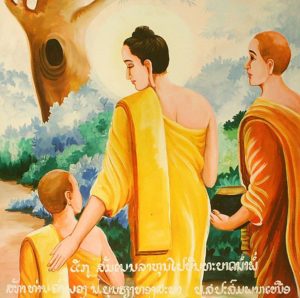Buddhists have been producing art for 2,500 years across two continents, so, rather than trying to introduce it all, I will share the most inspiring and exciting bits. Original, ancient Buddhism made no images of the Buddha but used only simple symbols. The Buddha’s footprints marked the spiritual path. A wheel with eight (or 32) spokes symbolized the eight-fold path and the four turnings of the wheel. It was the Greek influence that created the first images of the sitting Buddha.
Even so, statues of the Buddha sitting in meditation are the most widespread form of Buddhist art. In simple wood, or stone, or elaborately decorated with gold leaf, they are reminders of the peace cultivated through meditation. There are also statues of the Buddha before his awakening, starving, a reminder of both dedication and misdirected effort. And statues of him lying at rest, showing the peace he felt even as the death of the body approached.
Some sects of Buddhism see Buddha and great beings (Bodhisattvas) as semi-divine beings or saints.
These groups tend to create larger Buddhas and adorn them with more gold. Those who emphasize the Buddha’s humanity tend to make simpler statues of common materials, but they are nonetheless refined and beautiful.
 Tibetan Buddhism offers many art forms, including Tankas, paintings of Buddhas and Bodhisattvas on cloth, and sand mandalas. Sand mandalas are most amazing. They take several days to make. More than a yard across, they are made by monks carefully pouring colored sands to create images of the Buddha and Bodhisattvas in a large wheel. Then, when the monks are finished, they pour away the sand. This art is not meant to last. The work of creating it is a discipline of the mind. And the destruction of it is a reminder of impermanence, a teaching that we can learn not to suffer when we lose things, or when people die.
Tibetan Buddhism offers many art forms, including Tankas, paintings of Buddhas and Bodhisattvas on cloth, and sand mandalas. Sand mandalas are most amazing. They take several days to make. More than a yard across, they are made by monks carefully pouring colored sands to create images of the Buddha and Bodhisattvas in a large wheel. Then, when the monks are finished, they pour away the sand. This art is not meant to last. The work of creating it is a discipline of the mind. And the destruction of it is a reminder of impermanence, a teaching that we can learn not to suffer when we lose things, or when people die.
My own favorite Buddhist art is the work of the Zen masters of China, Vietnam, Korea, and Japan. Usually done in rich black ink on fragile white rice-paper, each work is created in a single moment of concentration. The artist prepares paper and ink, meditates, holds the image in mind, and then writes it, moving his whole body to move the pen, in a brief moment.
Zen art often includes words along with images
Bada Shanren (China, 1626-1705) created wonderful fish and birds with wide-open, wise eyes. In his later years, he produced rich landscapes. Yamaoka Tesshu (1836-1888) was perhaps the most prolific calligrapher in the history of Japan. He is believed to have created over 500,000 pieces, and he donated them to hospitals and other services, who then sold them to raise money. His calligraphic poetry had humor with a point. For example, on a ladies fan, he inscribed, “When the flies go away, the mosquitoes come out. Buy now, while the June sales are on!” This verse speaks at many levels. It is a reminder of the First Noble Truth, that, at every moment of life, there is suffering. It is a reminder that the fan can keep away bugs. It is a reminder that, if you buy now, you are being charitable. And it is a reminder that the path of Zen is available each moment, so anyone can awaken.
Many living Zen masters produce calligraphy or art to express their awakening
Today, in the US, Kaz Tanahashi continues the tradition of Zen calligraphy and brings color to the work. His art and workshops are vibrantly alive.
After 27 years of meditating, I am beginning to practice Zen calligraphy. I find I can only create good work if I am in a deep state of concentrated love. It is not easy to reach. But it lasts when I get there. And art is a wonderful side effect I can share.





